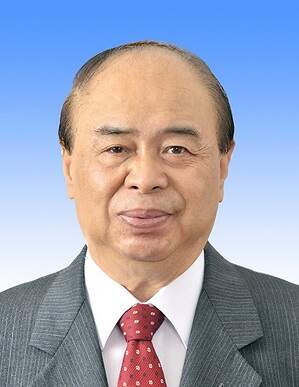
-
Dacheng Wang
Ph.D, Prof., CASM
-
Principal Investigator National Laboratory of Biomacromolecules, IBP
Research Interests: The three dimensional structures of proteins and their structure-function relationships and the protein engineering
Email: dcwang@ibp.ac.cn
Tel: 010-64888547
Address: 15 Datun Road, Chaoyang District, Beijing, 100101, China
Chinese personal homepage
- Biography
-
1958 - 1963 University of Science and Technology of China, B. Sc. in Biophysics
1963 - 1986 Primary Investigator, Assistant Investigator, Associate Investigator, Institute of Biophysics, Chinese Academy of Sciences
1982 - 1984 Alexander von Humboldt Research Fellow, Max-Plank Institute of Biochemistry, Department of Macromolecular Structure, Germany
1988 Wellcome Research Fellow, Department of Chemistry, York Univeristy, Great Britain
2005 Academician, Chinese Academy of Sciences
1997 - Editor-in-Chief,Progress in Biochemistry and Biophysics
2008 - Editor-in-Chief,Science in China – Life Sciences
Past positions: Vice Director of the Institute of Biophysics; Director of the Center for the Molecular Biology, Institute of Biophysics; Vice Chairman of the Crystallographic Society of China; Vice Chairman of the Biophysical Society of China.
- Awards
- Membership in Academies & Societies
- Research Interests
-
The research of our group has focused on the three dimensional structures of proteins and their structure-function relationships and the protein engineering of for a rather long time. Previous research subjects included protein hormones, polypeptide neuron toxins, and some defense proteins with antifungal, antiviral, and antitumor activities. It has participated in the structural analysis of pig insulin, the first proteins to be studied by crystallography in China. The major research achivements were received two Second Prizes of the National Natural Science Award of China and one First Prize of the Science Progress Award of the Chinese Academy of Sciences.
The current research interest of the group is on the structural biology of pathogenesis, especially the structure-function relationships and molecular mechanisms of proteins involved in diseases caused by both exogenous factors (such as infections by pathogenic microbes) and endogenous factors (such as naturally occurred mutations). The studies are essential for illustrating the mechanisms of the onset and defense of relative diseases and providing accurate knowledge and new idea to disease prevention and drug design. Our resent research are focused on the following three subjects:
1. Critical pathogenic protein & complex from pathogenic microbes
a. Structural and mechanistic studies of proteins related to the infection, persistence, and drug resistance of Mycobacterium tuberculosis;
b. Structure-function relationship and pathogenic mechanism analyses of the effector proteins of Gram-negative bacteria, especially the virulence proteins from the Type III, IV and VI Secretion Systems of Shigellaflexneri, Helicobacter pylori and Pseudomonas aeruginosa, respectively;
2. The Protein structure-functional basis for some endogenous disease (gene mutation caused), including neurodegenerative disease Ataxia with Oculomotor Apraxia Type 1 (AOA1), Cerebral cavernous malformation (CCM).
3. Structural biology of pattern recognition receptors of pathogen-associated molecular patterns (PAMPs)
Toll-like receptors (TLR) and NOD-like receptors (NLR) are major functional proteins to recognize conserved PAMPs and initiate appropriate immunological signaling. We are concentrated on the recognition of lipopolysaccharides from pathogen by human TLR1/TLR2/TLR6, to uncover the mechanisms by which the lipopolysaccharides are recognized by different TLR heterodimers and initiate strong immunological responses. We are also investigating the structures of NLR using combined technologies of X-ray crystallography and EM.
- Grants
- Selected Publications
-
Selected Publications(2010 - 2016)
1. Ding, J., Wang, K., Liu, W., She, Y., Sun, Q., Shi, J., Sun, H.,Wang, D.-C.*, and Shao, F.* (2016). Pore-forming activity and structural autoinhibition of the gasdermin family.Nature535, 111-116.
2. Wang, X., Hou, Y., Deng, K., Zhang, Y.,Wang, D.-C.*, and Ding, J.* (2015). Structural Insights into the Molecular Recognition between Cerebral Cavernous Malformation 2 and Mitogen-Activated Protein Kinase Kinase Kinase 3.Structure23, 1087-1096.
3. Feng, H., Ding, J., Zhu, D., Liu, X., Xu, X., Zhang, Y., Zang, S.,Wang, D.-C.*, and Liu, W.* (2014). Structural and Mechanistic Insights into NDM-1 Catalyzed Hydrolysis of Cephalosporins.Journal of the American Chemical Society136, 14694-14697.
4. Wang, W., Ding, J., Zhang, Y., Hu, Y.*, andWang, D.-C.*(2014). Structural insights into the unique single-stranded DNA-binding mode of Helicobacter pylori DprA.Nucleic Acids Research42, 3478-3491.
5. Li, W.-J., Li, D.-F., Hu, Y.-L., Zhang, X.-E., Bi, L.-J.*, andWang, D.-C.*(2013). Crystal structure of L,D-transpeptidase LdtMt2 in complex with meropenem reveals the mechanism of carbapenem against Mycobacterium tuberculosis.Cell Research23, 728-731.
6. Yu, Q., Hu, L., Yao, Q., Zhu, Y., Dong, N.*,Wang, D.-C.*, and Shao, F.* (2013). Structural analyses of Legionella LepB reveal a new GAP fold that catalytically mimics eukaryotic RasGAP.Cell Research23, 1-13.
7. Xu, X., Wang, X., Zhang, Y.,Wang, D.-C.*, and Ding, J.* (2013). Structural Basis for the Unique Heterodimeric Assembly between Cerebral Cavernous Malformation 3 and Germinal Center Kinase III.Structure21, 1059-1066.
8. Hu, Y., Jiang, F., Guo, Y., Shen, X., Zhang, Y., Zhang, R., Guo, G., Mao, X., Zou, Q.*, andWang, D.-C.*(2011). Crystal structure of HugZ, a novel heme oxygenase from Helicobacter pylori.J Biol Chem286, 1537-1544. Selected into “the Encyclopedia of Inorganic and Bioinorganic Chemistry” in 2012 by John Wiley & Sons, Ltd.
9. Gong, Y., Zhu, D., Ding, J., Dou, C.-N., Ren, X., Gu, L., Jiang, T.*, andWang, D.-C.*(2011). Crystal structures of aprataxin ortholog Hnt3 reveal the mechanism for reversal of 5′-adenylated DNA,Nature Struct Mol Biol.18, 1297–1299.
10. Hu, Y., Gai, Y., Yin, L., Wang, X., Feng, C., Feng, L., Li, D., Jiang, X.N.*, andWang, D.-C.*(2010). Crystal structures of a Populus tomentosa 4-coumarate: CoA ligase shed light on its enzymatic mechanisms.Plant Cell22, 3093-3104.
(From Dacheng Wang, November 22, 2018)

